Jump to the recipe’s instructions
Or, in other words, foolproof ratatouille.
Since I’m French it was not long before I was going to present a typically French recipe. I guess everybody has heard of ratatouille by now, especially since the release of the delicious 2007 Pixar movie, even if the dish presented there is not a real ratatouille but a provençal tian, more precisely a version of it called confit Byaldi.
First, let me get some facts out of the way. The ratatouille is a simple vegetable dish from Nice, a town in Provence, in the south of France. I won’t enter here into the debate as to whether Nice is really in Provence or not. Niçois themselves claim a strong independent culture, and the county of Nice has had a complicated history. The fact is that now, Nice is located in the Provence region. The word ratatouille itself comes from the Occitan language ratatolha, but the term has, it seems, an obscure origin, laced with legends and half-truths. What is true though is that rata is a military slang term for a coarse stew, and that touiller means to stir. Saying from this that ratatouille is just a vegetable stew is however a plunge I’m not ready to take.
All this leads to my second point. Let get this straight. Ratatouille is not a stew. You heard me right: ratatouille is NOT a stew. Have you ever come across these soupy, mushy, watery dishes that pose as ratatouille? Well, it’s because they have been cooked like a stew. Which means a ratatouille should never be made in a slow cooker. Neither should you put your vegetables all at once in a pot and call it a day. Please, stay away from these “one pot recipes” that promise to save you time and cleaning. A ratatouille deserves more than that. It deserves love, understanding, a bit of savoir-faire, and a pan. Yes, a frying pan. In the traditional ratatouille, the vegetables are fried separately, then layered in a dish and possibly baked. This way of doing preserves the taste of the vegetables and prevents them from being overcooked.
Which brings me to my third point, the ingredients themselves. A ratatouille is made with tomatoes, onions, bell peppers, egg plants and zucchini, and seasoned with garlic, thyme, bay leaves, rosemary, oregano or marjoram, possibly a little Espelette pepper (it gives depth to the tomatoes), and that’s it. No squash, no beans, no vinegar, no wine, no lardons (yes I’ve seen this, a ratatouille cooked with bacon strips, but I will spare you this heresy and not give you any link to it. You’re grown-ups, you can google it yourselves if culinary adventures entice you. But not on my watch!) And of course, olive oil. The beauty of this recipe is that it uses about one tbsp. of oil, so we’re on the light side. I like to add olive oil after cooking though, in my plate, on the ratatouille served warm or cool (in my opinion, one should never serve ratatouille piping hot. The flavors are best developed when it cools down a little).
Now, you’ll tell me – and you’ll be right – this is all well and good, but it seems to be kind of a hassle to make. Frying all the vegetables separately, then putting them back in a dish must take some time. Granted, ratatouille requires a bit of patience. So, how is it possible to make this marvelous dish while being lazy? It’s where I come to your rescue. I devised a way of doing a ratatouille which combines the best of two worlds: savor and laziness. Well, it’s all relative, of course, and this recipe is maybe the least lazy I’ve done in a while, but bear with me. If you follow my instructions to the letter, it should be a breeze. And hassle-free. Promise.
First, gather all your vegetables and admire them. Aren’t they beautiful?

Okay, you can skip this part if you’re in a hurry. Besides vegetables, you’ll need onions, garlic, some extra virgin olive oil and fresh or dried herbs. In this recipe, I put rosemary, bay leaves, thyme, a bit of chili flakes (I didn’t have Espelette peppers, but if you can get your hand on them, it’s a must), and dried oregano at the end of the cooking (oregano loses its flavor if heated too long, so it’s better to add it when the dish has stopped cooking). I usually prefer to use fresh herbs when I can, but this time I didn’t have any, and it was still very good.
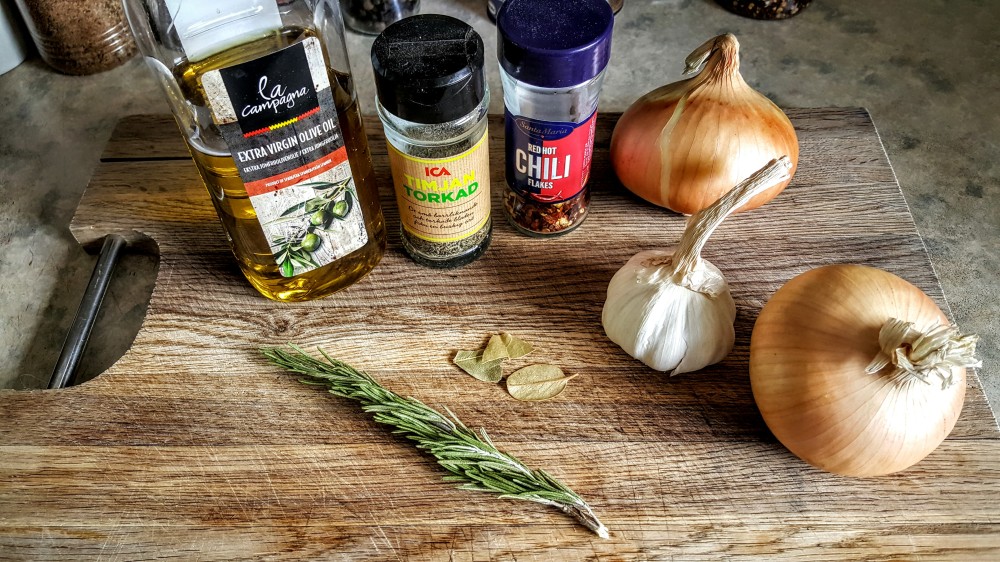
Let’s start. First, slice your onions. Heat a tbsp of olive oil in a big pan (the biggest you have, actually, the vegetables will shrink eventually, but at the beginning they take quite some space).

When the oil is hot, put the onions in the pan and fry them. They should end up like this:
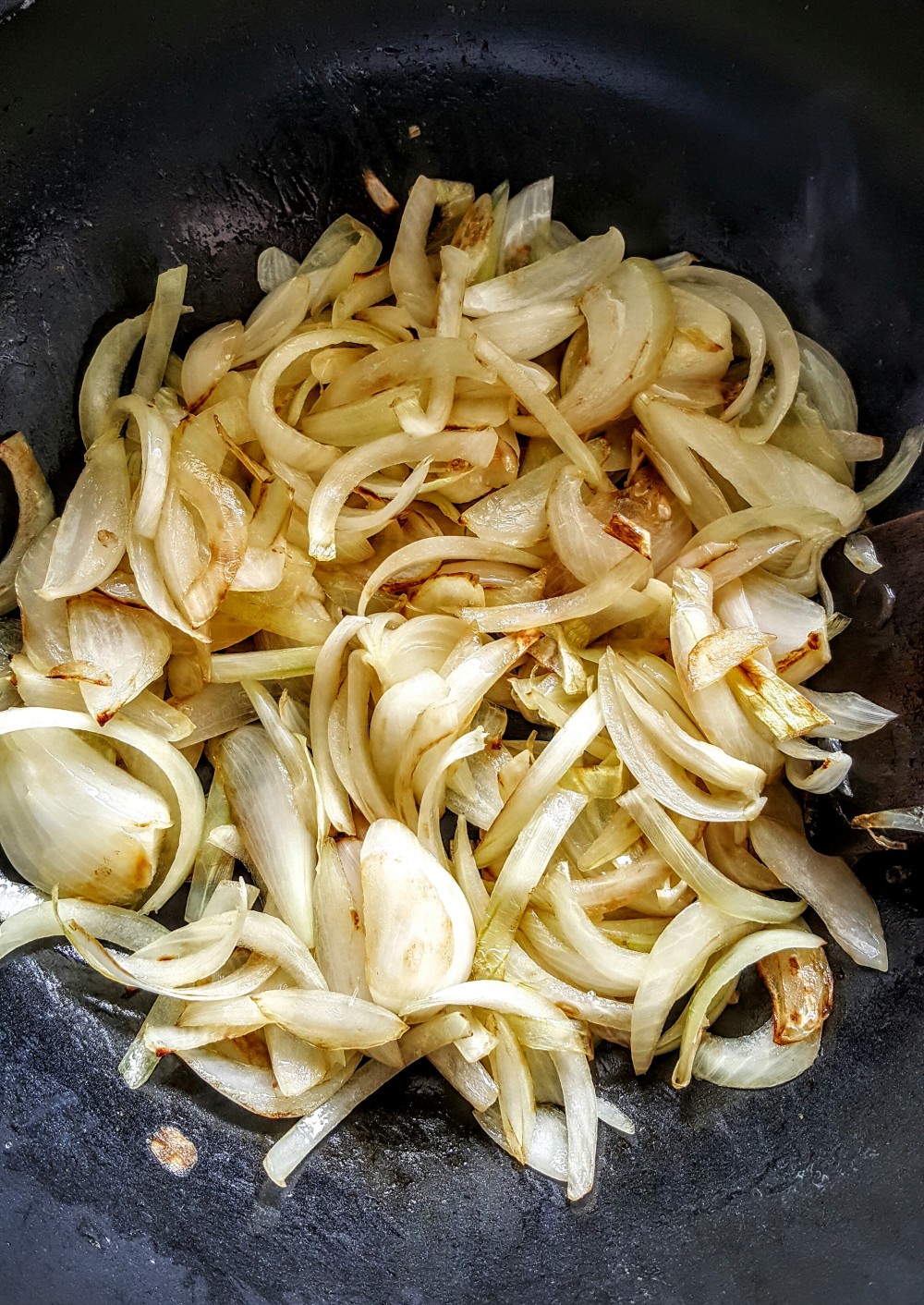
While they’re cooking, dice your tomatoes and crush your garlic. I used fresh tomatoes here, but it is perfectly acceptable in my book to use a can of crushed tomatoes if you are in a hurry. I know it’s unorthodox and I would probably be pilloried by the great keepers of ratatouille if they knew it, but when you’re lazy sometimes you have to make compromises.
After 5 mn, or when the onions have taken a nice golden color, add the tomatoes, the crushed garlic, the herbs (save the oregano) and the chili flakes if you use them.
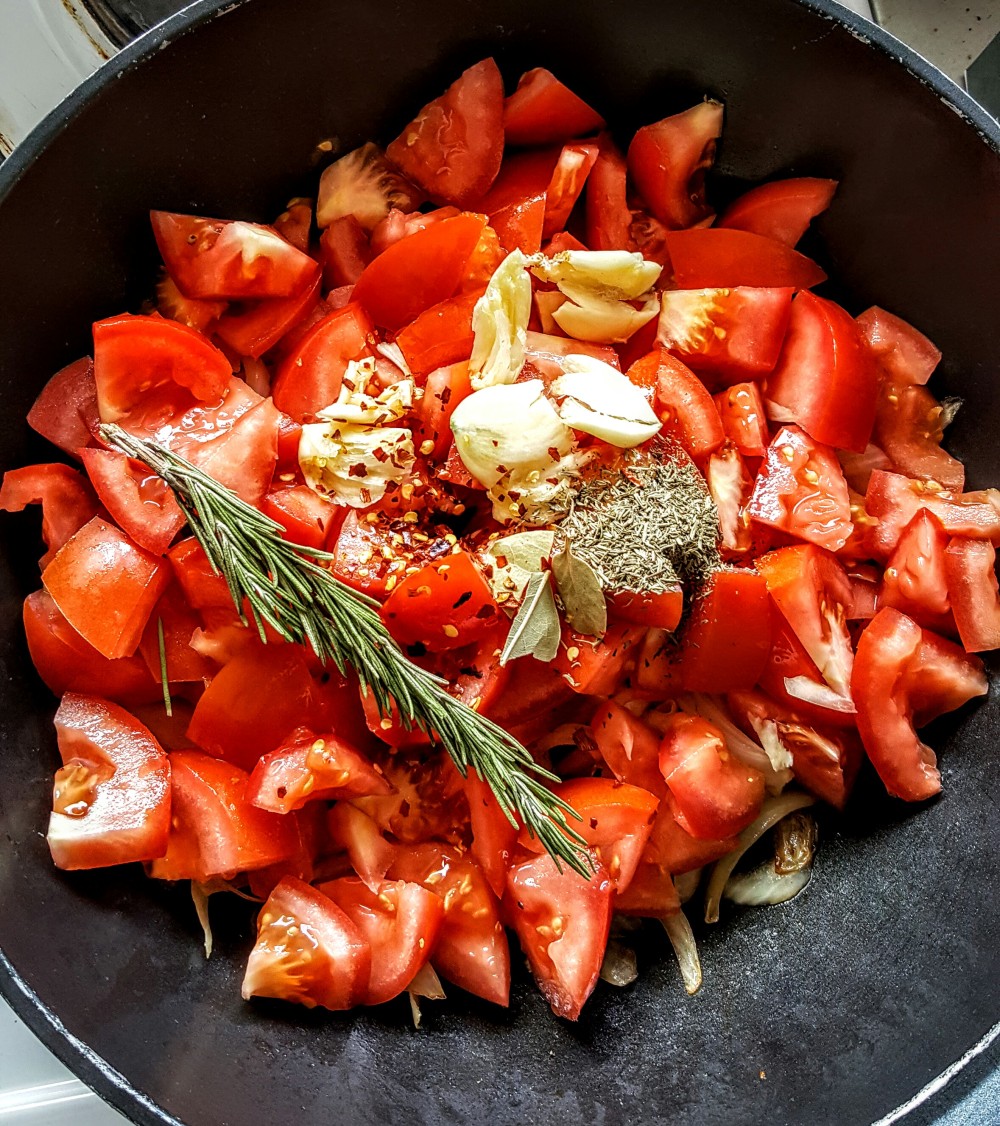
Stir and increase the heat to the maximum. You want the tomatoes to lose as much water as they can. Don’t put a lid on or it will take forever. I advise to use a splatter screen if you have one however, as the tomato juice can easily spill and stain everything around.
While the tomatoes are cooking, cut the bell peppers in big chunks. All the vegetables should have roughly the same size at the end, but it doesn’t have to be exact.
When the tomatoes are cooked through – it should take 15 mn – you can add the bell peppers. At the risk of repeating myself, it is very important that there is no more water at the bottom of the pan, like shown in the photo below. It doesn’t matter if tomatoes have stuck, as long as it’s not burnt, you’re all good. The water from the other vegetables is going to unstick everything.
Stir the bell peppers in the onions and tomatoes, and let them cook about 5 mn, or just the time to cut the eggplants, that you can add to the pan right away.
At this point it becomes a little tricky because your pan must be rather cramped with all these vegetables. Don’t worry, go on, stir and continue to cook everything on high heat. Again, there should be little to no water at the bottom of the pan.
While the eggplants are cooking, cut the zucchini. After 5 to 10 mn, the eggplants should be almost cooked through and your ratatouille should look like this:

It’s now time to add the zucchini.
Stir and let cook 2-3 mn, no more. Check the consistency of the zucchini with the blade of a knife. They should still be firm.
Turn the heat off, add some oregano, stir and cover the pan with a lid. The residual heat will finish to cook the zucchini without turning them into a mush.
When the ratatouille has cooled down a little, you can add salt and pepper to taste, rectify the seasoning if needed, and serve it with all the respect it deserves.
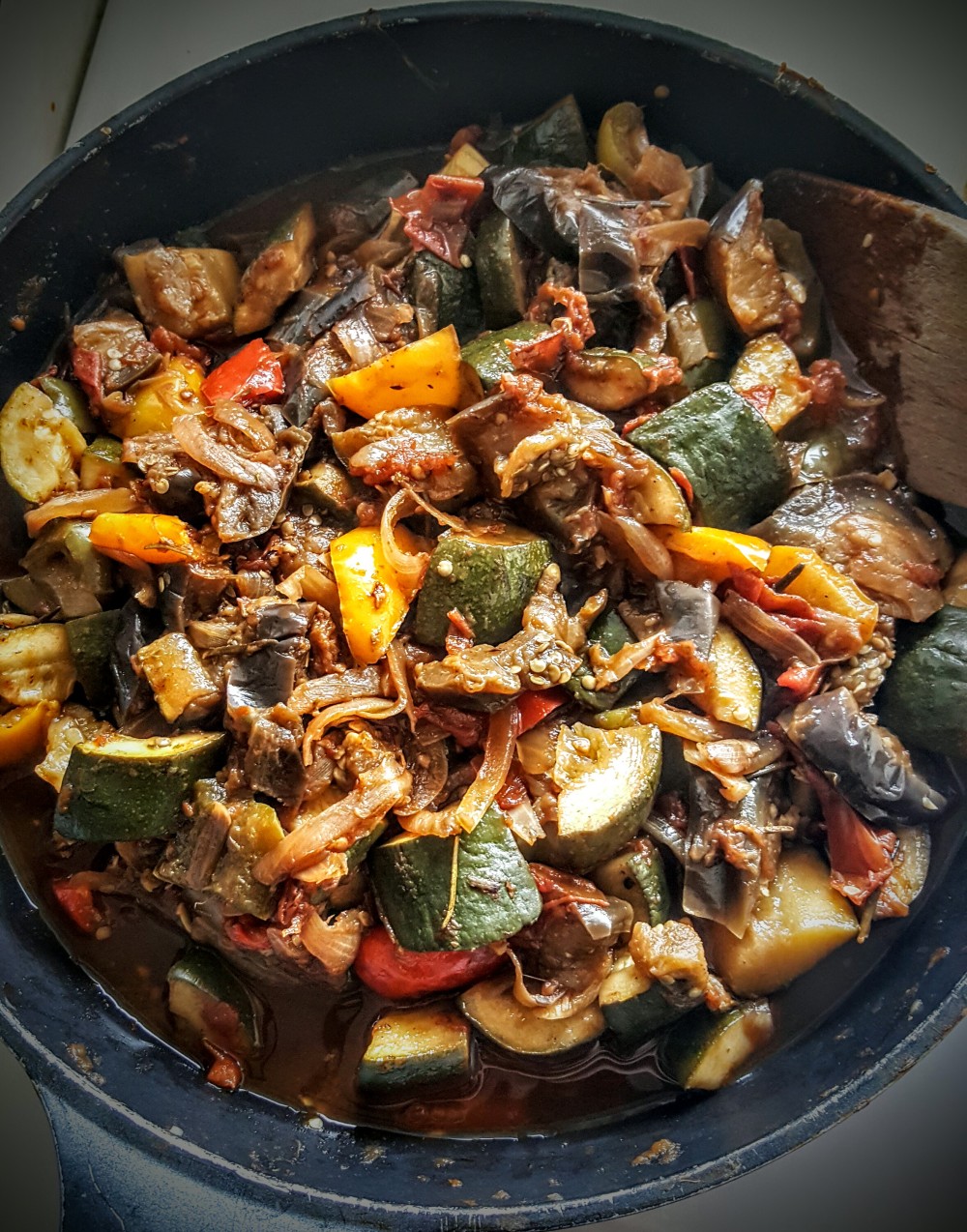
With this method of cooking, you can still see the shape of each vegetable in your dish.

Look at this glorious ratatouille!
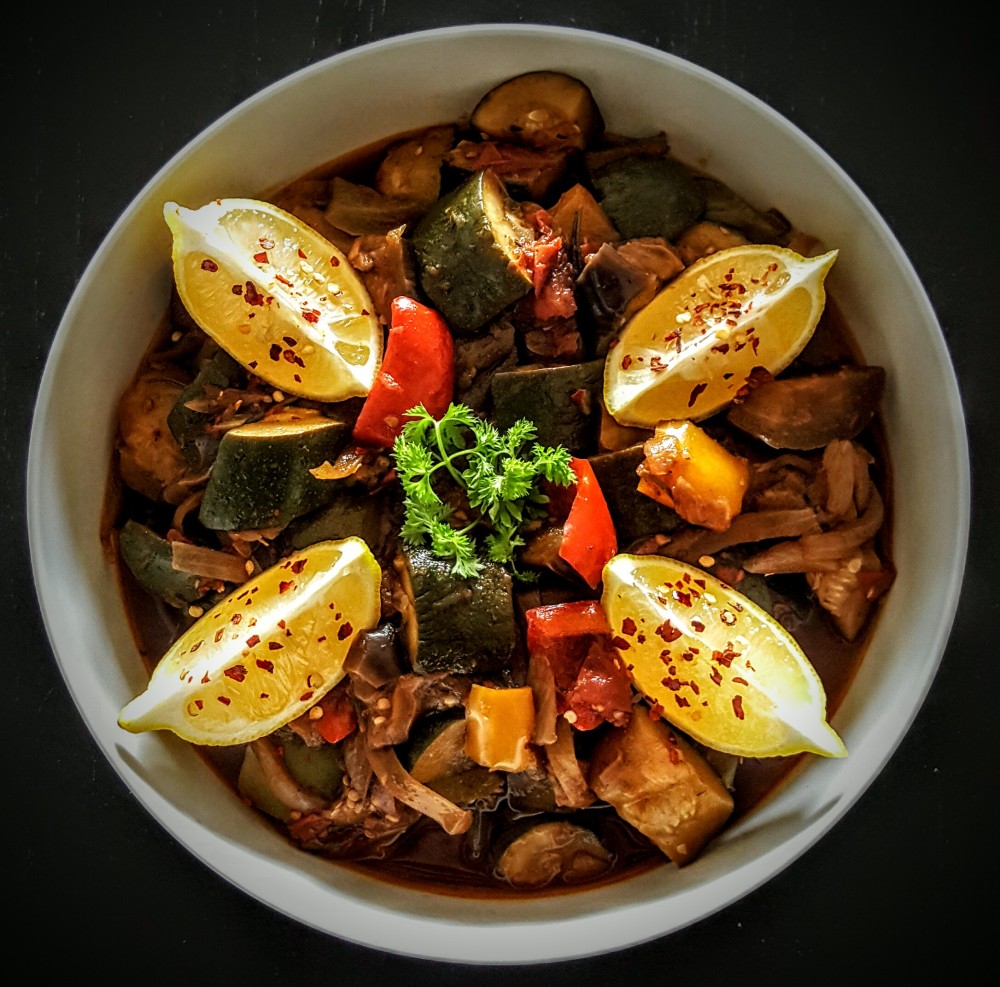
Ingredients for 6 pers.
4-5 tomatoes (or a can of crushed tomatoes)
2-3 bell peppers
2 eggplants
2-3 zucchini
2 onions
4-5 garlic cloves
1 rosemary branch (or a tsp. of dried rosemary)
1 thyme branch (or a tsp. of dried thyme)
1-2 bay leaves
1 tsp. oregano
1/2 tsp. Espelette pepper or chili flakes or chili powder (optional, but I like the kick it gives to the tomatoes)
1 tbs. extra virgin olive oil
salt and pepper, to taste
Preparation: 15 mn
Cooking time: 30 mn
Macros per serving: protein: 5; carbs: 26; fat: 3
The macros of this dish are an estimate and may vary depending on the quantity and size of vegetables.
Heat the olive oil in a frying pan. Slice the onions and throw them in the pan when the oil is hot. Fry them during 5-7 mn, or until they’re golden brown. While they’re cooking, dice the tomatoes in cubes and crush the garlic cloves with the blade of a knife. When the onions are well colored, put the tomatoes in the pan (or the crushed tomatoes if this is what you’re using) together with the herbs, the chili and the garlic, and some salt. Stir the content of the pan and let cook on very high heat until there is no more water in the pan, and the bottom is starting to stick. It should take approx. 15 mn.
During this time, cut the bell peppers in big chunks. Add them to the pan when the tomatoes are done, and cook them 3-5 mn, but no more. They will continue to cook with the other vegetables and you don’t want them too soft at this point.
While the bell peppers are cooking, cut the eggplants in two lengthwise, then again, to get 4 pieces. Then cut them in 2 cm thick bits. Add them to the pan, mix as much as you can, and continue to cook on high heat during approximately 10 mn. If it’s too hot lower the heat a little, to give time to the eggplants to render some water, but not too much. This is the delicate part, where you want your eggplants to cook through but not become all mushy.
What’s left to do, then, is to cut the zucchini the same way as the eggplants. Add them to the pan, stir and cook an additional 2-3 mn, then turn the heat off and put a lid on the pan. Let the ratatouille finish cooking in its own steam. Don’t worry if the ratatouille has yielded some water at this point, it will be re-absorbed when it cools down.
When it has cooled down a little, you can transfer it to a bowl, add some salt and pepper, pour extra virgin olive oil on it, decorate it with lemon slices, and most important, devour it.
You can serve it with any protein source. It goes well with veal, chicken, lamb or beef. It’s a great companion to summer barbecues, and to grilled fish.
This time I served it with chicken in a creamy lemon sauce. What an explosion of flavors in your mouth!






















I have a fondness for ratatouille. The very first time my eventual-husband asked me over to his place for dinner, he made ratatouille — and when adding the dried parsley the cover fell off the container and about half the jar dumped in. He was mortified. 14 years on, the memory still makes me simle.
LikeLike
Ha! I can imagine the disarray! I’m sure he had many occasions to make you many more delicious ratatouilles though.
LikeLike
Christy is excited to attempt this. We’ll let you know how it goes. 🙂
LikeLike
Please do! I’m always interested in your feedback.
LikeLike